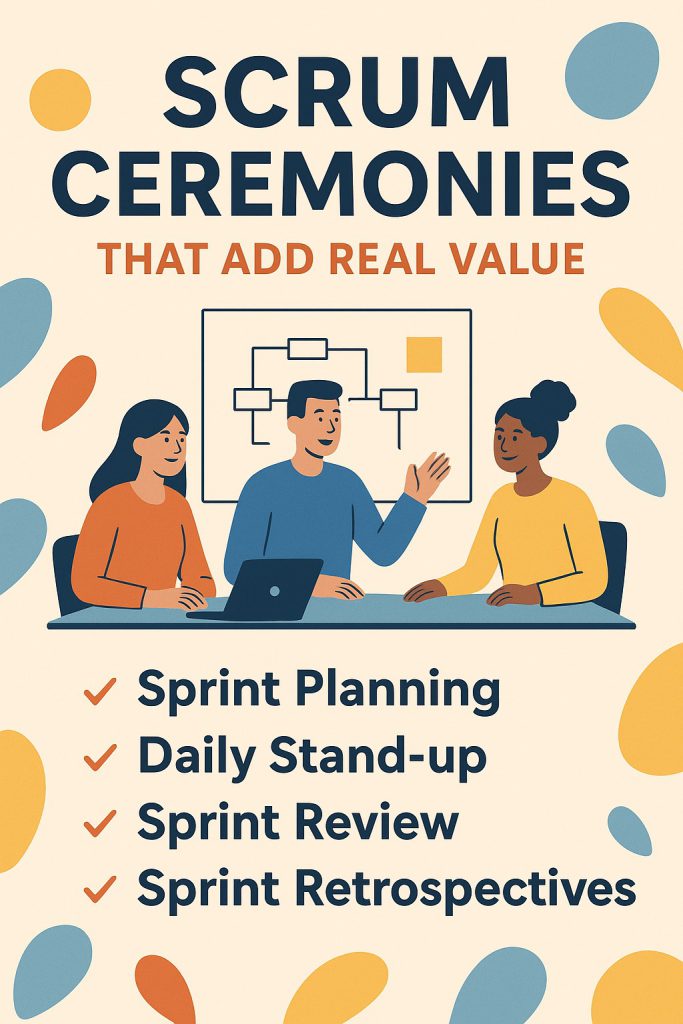In the fast-paced world of product development, Scrum has become one of the most widely adopted agile frameworks. At its core, Scrum provides a lightweight structure that helps teams deliver work in an iterative, collaborative, and customer-focused way. But as more organizations embrace Scrum, one of the most common complaints you’ll hear is: “Our Scrum ceremonies feel like a waste of time.”
It’s true—when done poorly, Scrum ceremonies can feel like endless meetings that eat away at productivity. But when executed with intention, they are not just calendar events—they are the heartbeat of agile teams. Each ceremony creates opportunities for collaboration, transparency, and course correction, which directly translates into value for the team, the business, and most importantly, the customer.
So, how do Scrum ceremonies add real value? Let’s take a closer look at each one, why it matters, and how to ensure your team is getting the most out of them.
Sprint Planning: Setting Purpose and Direction
Sprint Planning is often misunderstood as simply breaking down backlog items into tasks. In reality, this ceremony is the strategic launchpad for every sprint. It’s where the Product Owner, Scrum Master, and Development Team align on the sprint goal and decide what work will create the most value in the short term.
When Sprint Planning is done well, it does more than just fill the sprint with tasks—it answers the bigger question: Why are we doing this work, and how does it move us closer to our product vision?
Tips to add value:
Define a clear, inspiring Sprint Goal that connects backlog items to customer or business outcomes.
Encourage the team to challenge assumptions, ask questions, and refine scope before committing.
Use metrics like velocity trends and team capacity to keep planning realistic.
A good Sprint Planning session leaves the team not just with a to-do list, but with clarity, confidence, and shared accountability.
Daily Standups: Promoting Transparency and Focus
The Daily Scrum (or daily standup) often gets criticized as “just status updates.” But when it becomes that, it loses its power. The real purpose of this ceremony is inspection and adaptation. It’s a quick checkpoint where the team synchronizes progress, identifies roadblocks, and makes micro-adjustments to stay on track toward the sprint goal.
Tips to add value:
Keep it short—no longer than 15 minutes.
Focus on collaboration, not reporting to the Scrum Master. Team members should be talking to each other, not to management.
Ask: “What do we need to adjust today to stay on track with our sprint goal?”
When done with discipline, daily standups help teams avoid surprises, surface issues early, and maintain a steady rhythm.
Sprint Review: Delivering Value, Not Just Features
The Sprint Review is more than a demo—it’s a business conversation. This ceremony creates a platform where the team showcases what they’ve built, stakeholders provide feedback, and everyone discusses how the product is evolving against goals.
This is where value delivery becomes visible. It’s not about how many backlog items are completed, but about whether the product increment meets real user needs and aligns with strategic priorities.
Tips to add value:
Frame the review around customer outcomes—not just a list of features.
Invite diverse stakeholders who can provide meaningful feedback.
Use the session as a two-way dialogue, not a one-way presentation.
A strong Sprint Review builds trust, fosters transparency, and ensures alignment between teams and business stakeholders.
Retrospectives: Driving Continuous Improvement
If there’s one Scrum ceremony that has the potential to transform team culture, it’s the Sprint Retrospective. This is where the team inspects its own processes, relationships, and collaboration—then decides on actionable improvements for the next sprint.
Without retrospectives, teams risk stagnation. With them, teams continuously evolve, becoming not just faster but smarter.
Tips to add value:
Create psychological safety so team members feel comfortable sharing openly.
Rotate facilitation styles to keep the discussion engaging and fresh.
Always end with one or two concrete actions to implement in the next sprint.
When retrospectives are taken seriously, they cultivate a culture of learning, adaptability, and resilience.
The Role of the Scrum Master
Behind every valuable Scrum ceremony is a Scrum Master who facilitates with intent. The Scrum Master’s role is not to enforce rules, but to enable collaboration, remove impediments, and ensure that each ceremony serves its purpose. When this leadership role is active, Scrum ceremonies transform from “just another meeting” into engines of value creation.
Why Scrum Ceremonies Matter
Scrum ceremonies are not arbitrary—they are deliberately designed touchpoints that keep teams aligned, transparent, and adaptive. They:
Strengthen communication within agile teams.
Provide frequent opportunities to inspect and adapt.
Foster a sense of shared purpose and accountability.
Ensure that value—not just output—is delivered consistently.
In short, Scrum ceremonies, when done right, are not a waste of time—they are the very structure that allows teams to thrive in complex and fast-changing environments.
Final Thoughts
Agile success is not just about following processes—it’s about making those processes work for you. Scrum ceremonies are only valuable if they are treated as opportunities, not obligations. With the right mindset and discipline, they can become powerful tools for delivering outcomes that matter to both customers and businesses.
If your ceremonies feel like a drain instead of a driver, it’s time to refocus on their original intent: to inspect, adapt, and deliver real value.
👉 Enroll today and take your career and your leadership to the next level with scrumconsult.com
To learn more about Scrum Master Certification in Lagos, Agile Expert, Project Management, Product Owner, Lean Six Sigma Green Belt, Lean Six Sigma Black Belt, SMC, PSM, and CSM, kindly visit scrumconsult.com

